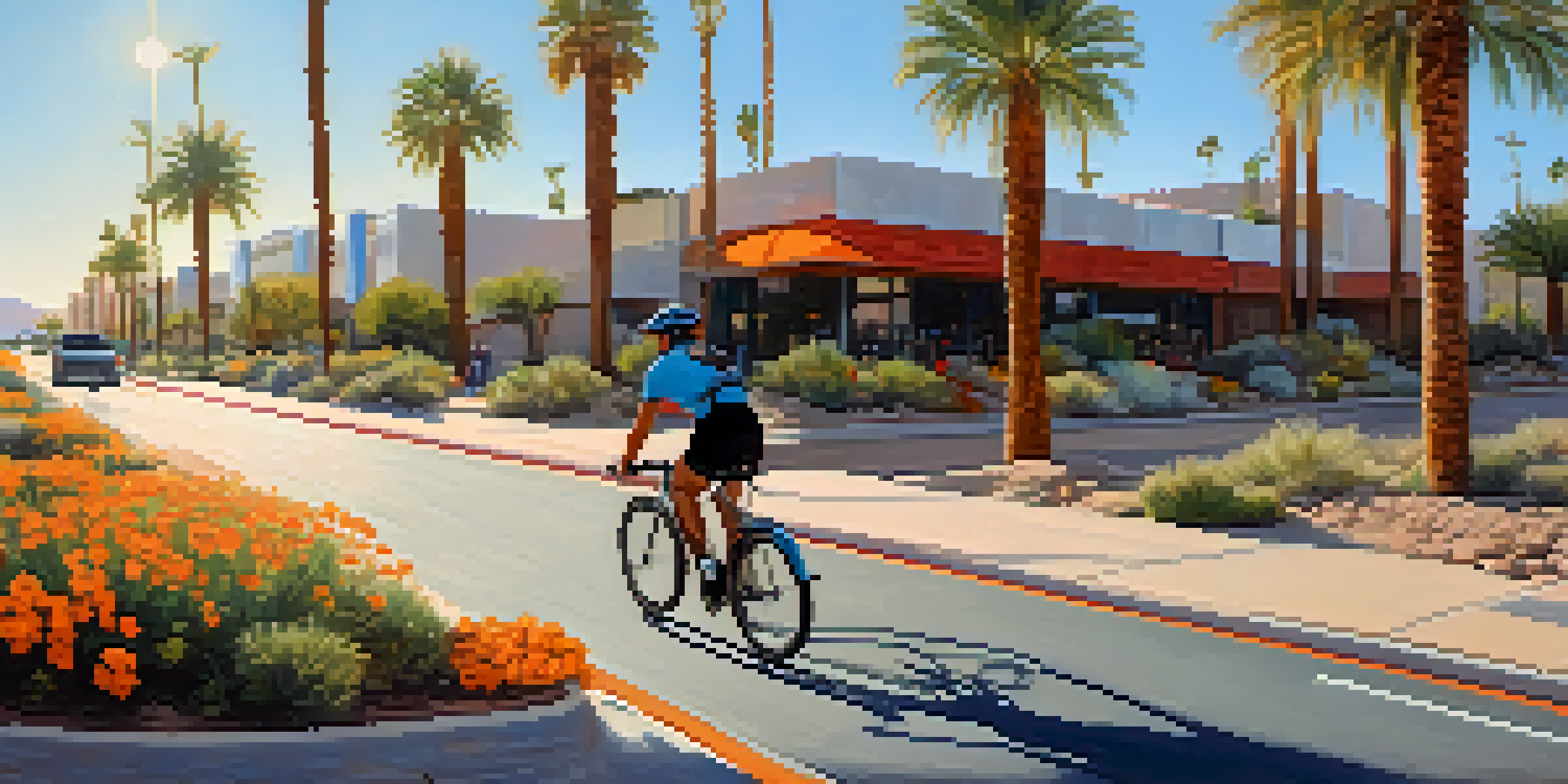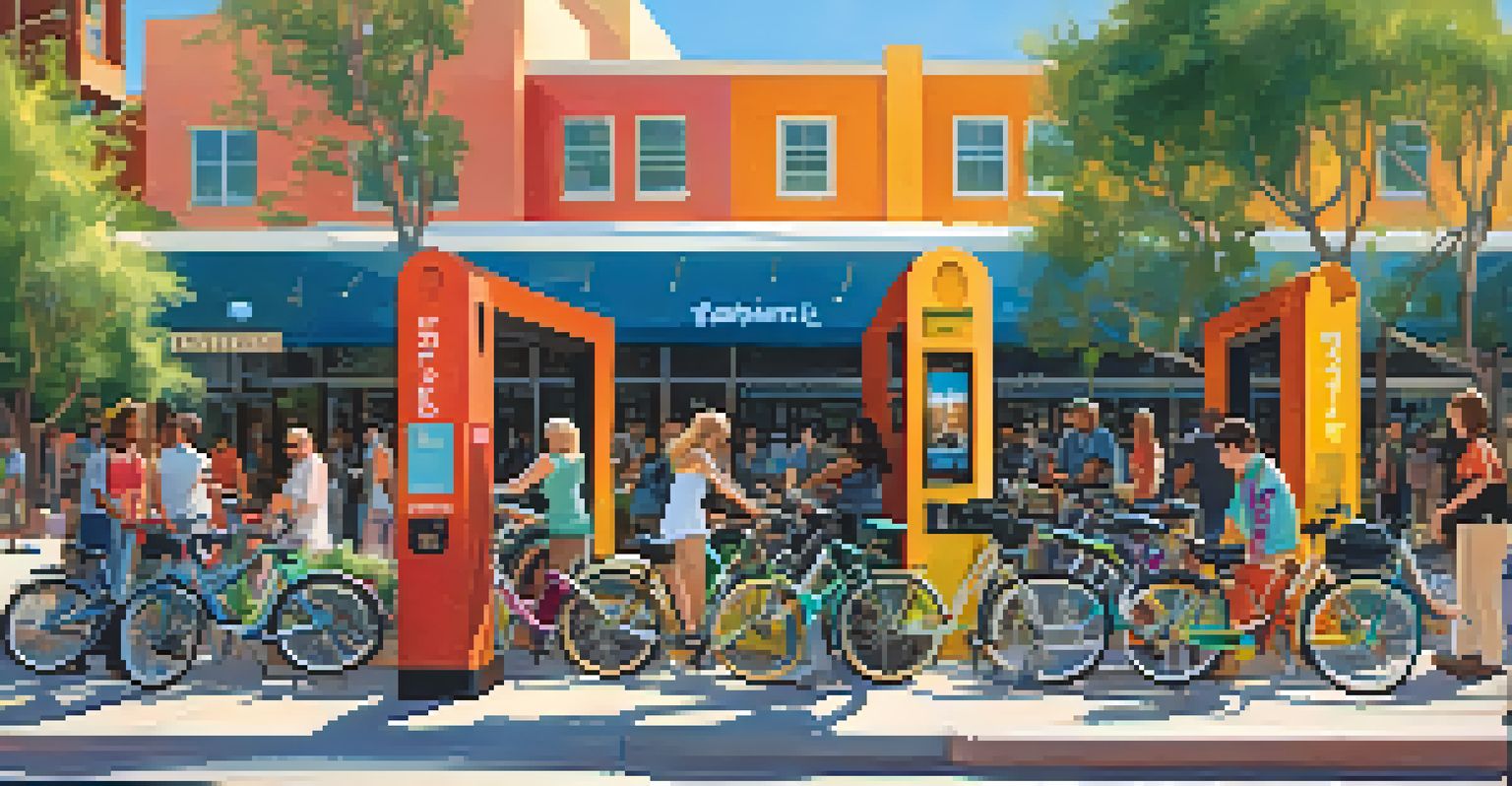The Role of Biking in Arizona's Public Transport Framework

Introduction: Biking as a Transport Solution in Arizona
Biking is more than just a recreational activity in Arizona; it’s becoming a vital component of the state’s public transport framework. As urban areas grow and traffic congestion increases, many cities are looking for sustainable alternatives. Biking offers a flexible, eco-friendly solution that can significantly reduce carbon footprints while providing an efficient means of transportation.
Cycling is not just a mode of transport; it’s a lifestyle that promotes health, sustainability, and community connection.
In Arizona, biking is gaining traction as part of a broader strategy to integrate various modes of transport. For instance, cities like Phoenix and Tucson are enhancing their bike lanes to make cycling safer and more accessible. This not only encourages residents to consider biking as a viable commuting option but also contributes to healthier lifestyles.
Moreover, leveraging biking within the public transport system can help address issues like parking shortages and public transit overcrowding. By creating a comprehensive network of bike paths and securing bike racks at transit stations, cities can facilitate a seamless connection between cycling and public transport.
Benefits of Biking in Urban Arizona
Biking offers numerous benefits, particularly in urban environments like those found in Arizona. Firstly, it promotes physical health, encouraging individuals to engage in regular exercise. Given the sunny weather and beautiful landscapes, biking can also enhance mental well-being, offering a refreshing break from daily routines.

Additionally, biking can significantly reduce traffic congestion. With more people opting to bike instead of driving, the number of vehicles on the road decreases, leading to less pollution and improved air quality. This is particularly crucial in cities that often face air quality challenges due to high traffic volumes.
Biking Enhances Urban Mobility
Biking is becoming an essential part of Arizona's transport framework, offering a sustainable and efficient alternative to traditional commuting.
Lastly, integrating biking into public transport frameworks can lead to economic benefits. Cities can attract more tourists interested in cycling while also reducing the costs associated with maintaining extensive road networks. This balance can create a win-win scenario for residents and visitors alike.
Infrastructure Development for Biking
For biking to thrive as part of Arizona's public transport framework, robust infrastructure is essential. This includes dedicated bike lanes, bike-sharing programs, and secure parking facilities. Cities are beginning to invest in these aspects, recognizing that a well-planned infrastructure encourages more residents to adopt biking.
The bicycle is a simple solution to some of the world's most complicated problems.
Moreover, the development of bike paths should be strategically aligned with existing public transport routes. By ensuring that bike lanes connect seamlessly to bus and light rail stations, commuters can easily transition between different modes of transport. This integration fosters a more cohesive public transport network.
As cities like Phoenix and Tucson expand their biking infrastructure, they are also incorporating community feedback. Engaging residents in the planning process can lead to more effective designs that cater to the needs of local cyclists, ultimately making biking a more appealing option.
Challenges Facing Biking Integration
While biking presents numerous benefits, integrating it into Arizona's public transport framework is not without challenges. One significant hurdle is the perception of biking safety. Many potential cyclists hesitate to ride due to concerns about traffic, accidents, and inadequate bike lanes.
Additionally, weather conditions can pose challenges for biking year-round. Although Arizona boasts a warm climate, the extreme heat during summer months can deter people from cycling, especially during peak hours. Addressing these concerns through public education and infrastructure improvements is vital.
Infrastructure is Key for Biking
Robust biking infrastructure, including dedicated lanes and bike-sharing programs, is crucial for encouraging more residents to adopt cycling as a mode of transport.
Lastly, securing funding for biking initiatives remains a challenge. Local governments often prioritize larger transport projects, leaving biking initiatives underfunded. It's crucial for stakeholders to advocate for biking as a legitimate component of the public transport system to secure necessary resources.
Community Engagement and Support for Biking
Community engagement plays a critical role in promoting biking as part of Arizona's public transport framework. Local organizations and advocacy groups can help raise awareness about the benefits of cycling. They can also provide resources and support for those interested in biking.
Events such as bike-to-work days and community rides can foster a sense of camaraderie among cyclists. These gatherings not only encourage participation but also help to build a biking culture within the community. When people see their neighbors biking, they are more likely to consider it for their own commutes.
Moreover, educational programs that teach cycling safety can empower individuals to ride confidently. By addressing safety concerns and promoting safe practices, communities can create an environment where biking is seen as a viable and attractive option for transportation.
Biking and Sustainability Initiatives
Biking aligns perfectly with sustainability initiatives in Arizona. As cities strive to reduce their environmental footprints, promoting biking can significantly contribute to these efforts. Fewer cars on the road lead to lower carbon emissions, which is a win for the planet.
Furthermore, by integrating biking into public transport, cities can enhance their overall sustainability goals. For example, bike-sharing programs can reduce the need for car rentals and promote shorter, more eco-friendly trips. This shift can lead to more sustainable urban growth and development.
Community Engagement Drives Adoption
Active community involvement and educational initiatives play a vital role in promoting biking and addressing safety concerns among potential cyclists.
Lastly, biking encourages individuals to adopt a more environmentally conscious lifestyle. As people become more aware of the benefits of cycling, they may also become more interested in other sustainable practices, creating a ripple effect throughout the community.
Conclusion: The Future of Biking in Arizona
The future of biking in Arizona looks promising, especially as cities continue to recognize its role in the public transport framework. With ongoing infrastructure improvements and community support, biking can become a staple mode of transportation in urban areas. This shift not only benefits the environment but also contributes to healthier, more active lifestyles.
As more people embrace biking, the collective impact can lead to significant changes in traffic patterns and urban development. Cities are likely to see reduced congestion and improved air quality, creating a more livable environment for everyone. Additionally, a vibrant biking culture can attract visitors and boost local economies.

Ultimately, the integration of biking into Arizona's public transport system represents a step toward a more sustainable and efficient future. With continued investment and community engagement, biking can transform from a leisure activity into a key component of daily commutes.